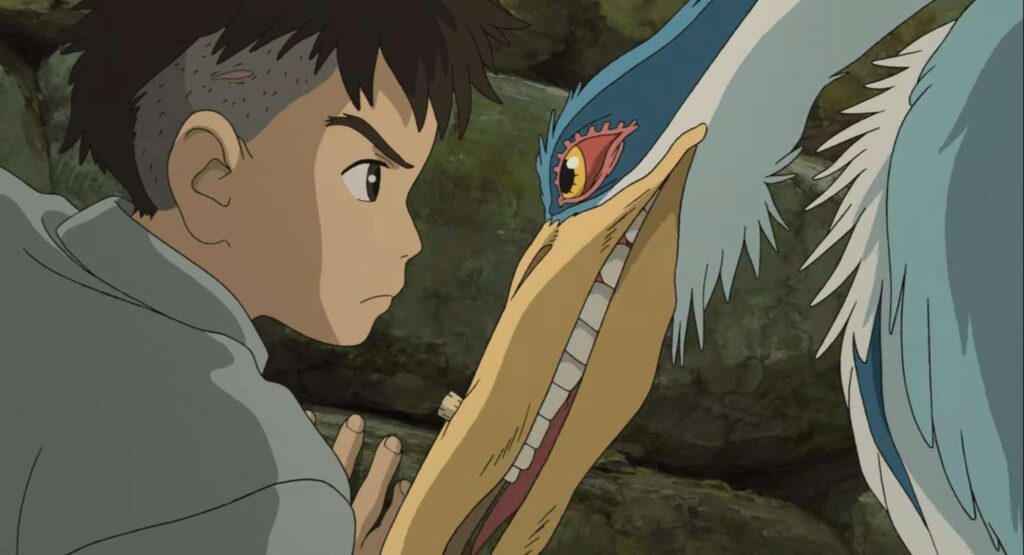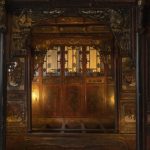For L, with you I never worry about getting lost.
While researching, I learned that The Boy and the Heron (originally titled in English as The Boy and the Heron) draws inspiration from the novel How Do You Live? by the late Genzaburo Yoshino—a writer who deeply influenced the ideas and animation style of director Hayao Miyazaki.
This latest offering from the familiar Studio Ghibli brought me a fresh experience. It carries echoes and details borrowed from Ghibli classics like My Neighbor Totoro, Spirited Away, Howl’s Moving Castle, Castle in the Sky, and Princess Mononoke.
Using my own feelings and imagination, I pieced together what I saw after my first viewing to write this reflection. I don’t plan to rewatch it—not because I’m uninterested in its deeper layers, but because it feels like Miyazaki intended for some things to remain unclear until the right moment arrives. There’s a calm acceptance in that message, tinged with a hint of reluctance.
It sounds intricate, but as I write this, I realize The Boy and the Heron invites multiple interpretations. How you explain it matters less than how it hits you. People love reasoning things out, yet the most convincing arguments often spring from the heart, not the head.
A Brief Overview
The film opens with Mahito, a boy whose mother dies in a fire. Later, his father marries his mother’s younger sister, Natsuko, and they move to her rural hometown. There, a heron pesters Mahito, luring him to a gloomy, sealed tower tied to his great-uncle’s mysterious disappearance. Despite warnings from seven old housemaids and Natsuko about its dangers, Mahito steps inside.
I’ll leave the rest for you to discover. For now, I’ll share my thoughts on the symbols that caught my eye.
The Tower Master
According to the housemaids, Mahito’s great-uncle was a brilliant, book-obsessed man driven to madness. When a meteor crashed near his land, he resolved to build a tower around it. Once finished, he vanished—a state hovering between life and death.
To the world, he’s gone. But inside the tower, he endures as its master, crafting a private realm with rules he deems ideal. He tells Mahito the outside world is a terrifying place of fools, warmongers, and malice (a nod to wartime chaos).
The Tower Master rejects life. He seals himself in the tower, cocooned by knowledge gleaned from books. It shields him—and traps him—within his own biases. The tower’s layers mirror realms like heaven, earth, and hell.
He sees himself as a god shaping this balanced haven, but to some forced inhabitants (like the birds and parrots), it’s a hell. If you watch, you’ll notice their intellect and compassion barely grow. They eat, survive, and die. The “balance” he cherishes is a distortion, born from meddling too much in nature and reshaping it to his will.
He reminds me of mystics fixated on the spirit or scientists obsessed with remaking materiality—pushing progress by retreating. Their towering egos block life’s flow (the stones he uses might clog it, crystallized stagnation each person uses to delude themselves, crafting illusions to flee reality).
He hopes his descendant will inherit the tower. But Mahito wisely sidesteps the script his great-uncle wrote for him. He refuses, seeing the choice—and its burdens—as the old man’s self-made prison, not a legacy anyone should bear.
Having never truly lived, the Tower Master won’t easily die, even as the tower falls.
The Tower
The tower isn’t a character, but it’s pivotal to Mahito’s transformation. It imprisons its creator yet frees the one bold enough to reject its control. I see it as an alchemical forge, turning base metal into gold. Mahito is the hero facing trials (no hero emerges without challenges, a mission, and someone to save). This echoes Carl Rogers’ “process of becoming” and Carl Jung’s “hero archetype,” perhaps.
When the tower crumbles, releasing its contents, the Tower Master’s and Mahito’s realizations fracture in opposite ways. Tipping past equilibrium sparks chaos—and from that chaos, everything grows.
It also recalls the Tower card in Tarot. We build rigid beliefs, then must tear them down ourselves. Whoever ties the knot must untie it. Maturity is constructing yourself, watching it collapse, and building anew.
The Boy Mahito and the Heron
The film’s heart lies with Mahito and the heron. After losing his mother, his father’s marriage to Natsuko—eerily like yet unlike his mom—stirs a storm in him.
Adrift, the heron appears as his guide. It’s neither wholly good nor bad. I first thought it was the Tower Master’s agent, but it’s a distinct layer of Mahito’s growth. Once its task ends, it erases its own memory (adults were all kids once, but growing up blurs that past). So, what’s its role?
It leads Mahito to his inner conflicts and fears. From rage (starting fights), lies (about his head wound), and self-punishment (smashing a rock on his skull, shooting the heron’s beak) to the heron’s grounded slump and eventual flight (losing, then regaining purpose and faith).
The heron is Mahito’s inner world, unseen by him. It forces him to face death for a rebirth.
He must confront his mother’s death and the death of his old self—its biases shed for a new self with fresh awareness (we’re born twice: once as a body, once as an identity).
Braving death, Mahito finds it’s not so frightening. Hell is a revolving gate where new souls become new people. The universe (space-time) orders it all—you just pick the right door at the right time, guided by instinct, not calculation.
His mother’s fiery death loses its terror. He sees her young self wield flames—death as a return to essence. Natsuko’s birthing room ties birth and death as two sides of a coin: the gate of life is the gate of death, and through death comes birth.
Mahito and the heron mirror the raw upheaval from childhood to adolescence (rare for Ghibli to mark these stages with specific years).
The heron perks up when Mahito offers friendship. Accepting his flawed self—his malice, his lies—proves he can embrace an imperfect world like himself. Hating the world is hating yourself. He surpasses what his great-uncle, the Tower Master, couldn’t.
The heron bids farewell, fading into shadow. Familiar faces greet him, but he’s no longer the closed-off Mahito. His scars remain, but they’ve healed. He opens up, accepting life and death as inevitable.
In Place of a Conclusion
As I said early on, I don’t think The Boy and the Heron begs rewatching to decode its depths. My thoughts above are just what I felt—they’re not absolute.
Through a more grounded lens, a simpler story emerges: Grief over his mother’s death and his father’s remarriage traumatizes Mahito. He bashes his head with a rock, not blaming peers when his father asks—a sign of self-harm, maybe even suicidal intent, targeting a vital spot.
Exhausted physically and emotionally, blood loss sends him into a deep sleep and a dream. Real-life fragments (the tower, his great-uncle, his late mother, the housemaids) weave a tale to help him accept his loss and embrace his new stepmom and soon-to-be sibling as family. This self-soothing dream-healing is fascinating.
Dreams lack sequence or logic, blending the strange and familiar chaotically. That might make the film feel disjointed or confusing. But aren’t all dreams a puzzle?
The ending feels abrupt: after wild twists, it closes with Mahito and his new family, no further explanation. He gains no special powers, and no eerie heron or parrots lurk to hint at sequels.
That’s Miyazaki and Ghibli’s mark: finding the extraordinary in the ordinary, lingering on small details, pacing the story gently, knowing when sound sings and when silence hums. It reminds us of ordinary people facing loss, battling pain, yet holding onto goodness within—to accept life and themselves without malice. That’s how they live.
And you—how do you live?















